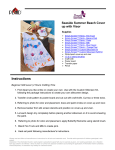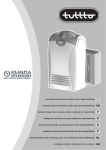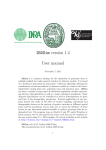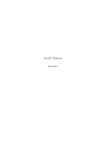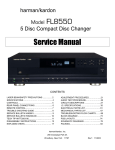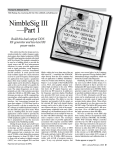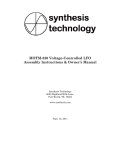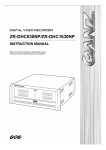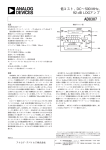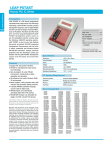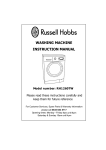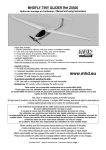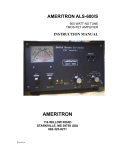Download universal timer/counter rf power meter fr1308 assembly
Transcript
UNIVERSAL TIMER/COUNTER RF POWER METER FR1308 ASSEMBLY MANUAL Copyright MW Instruments (C) 2005 http://www.mwinstruments.com Manual N° MME1308-0601 FR1308, assembly manual, MME1308-0601 1 FR1308, assembly manual, MME1308-0601 2 1) INTRODUCTION The FR1308 is an instrument that permits measurement of frequencies, period, pulse duration, and RF power. Please refer to the user manual for all informations regarding the use of this instrument. The kit FR1308 contains all required material including a special enclosure complete with a professionnal polycarbonate (Lexan) front panel overlay. To obtain reliable results, the FR1308 must be calibrated after its assembly. For this purpose MW Instruments recommandes a small but accurate frequency/power calibrator (ref CL2018). The calibration procedure is described in the user manual. All kits from MW Instruments are evolutive. New features are added from time to time and can be upgraded by changing the microcontroller. Please visit our Web site http://www.mwinstruments.com (support section) for upgrade procedures. The FR1308 is intended for persons having some experiences in kit assembly. The instrument has some SMD passive components (Surface Mounted Components) but this should not be a problem if you use an appropriate solder iron. Many drawings and pictures will help you in the assembly of this instrument. If you have any questions about this kit, feel free to contact the project designer at [email protected]. 2) COMPONENT PARTLIST This section describes the contents of the FR1308 kit. Please check all parts supplied in the kit bag against the list shown here. We have done our best to provide all parts without errors, but sometimes shortages do occur. If you find that you are missing a component, after carefully going through the parts bag and identifying the components against this part list, please contact us. FR1308, assembly manual, MME1308-0601 3 Picture Qty 1 1 1 1 1 1 5 1 1 5 1 5 5 3 1 1 1 1 1 1 Ref. Description Resistor 5,6 ohms 5% (GREEN BLUE GOLD GOLD) Resistor 52,3 ohms 1% R34 (GREEN RED ORANGE GOLD BROWN) Resistor 62 ohms 5% R10 (BLUE RED BLK GOLD) Resistor 100 ohms 1% R19 (BROWN BLK BLK BLK BROWN) Resistor 220 ohms 5% R22 (RED RED BROWN GOLD) Resistor 464 ohms 1% R4 (YELL. BLUE YELL. BLK BROWN) R5 R18 R28 Resistor 470 ohms 5% R29 R40 (YELL. VIOLET BROWN GOLD) Resistor 1 k 1% R15 (BROWN BLK BLK BROWN BROWN) Resistor 2,74 k 1% R14 (RED VIOLET YELL. BROWN BROWN) R8 R11 Resistor 4,7 k 5% R23 R27 R39 (YELL. VIOLET RED GOLD) Resistor 4,87k 1% R38 (YELL. GREY VIOLET BROWN BROWN) R2 R12 R13 Resistor 10k 1% R30 R37 (BROWN BLK BLK RED BROWN) R1 R3 R25 Resistor 11 k 5% R6 R26 (BROWN, BROWN, RED, GOLD) Resistor 20,5 k 1% R24 R31 R35 (RED BLK GREEN RED BROWN) Resistor 22 k 5% R9 (RED RED ORANGE GOLD) Resistor 33,2 k 1% R32 (ORANGE ORANGE RED RED BROWN) Resistor 56 k 5% R36 (GREEN BLUE ORANGE GOLD) Resistor 100 k 1% R21 (BROWN BLK BLK ORANGE BROWN) Resistor 100 k 5% 2W Oxydmetal R16 (BROWN BLK ORANGE GOLD) Resistor 898 k 1% R17 (GREY BLANC GREY ORANGE BROWN) R33 FR1308, assembly manual, MME1308-0601 4 Picture Qty Réf. 1 AJ1 1 AJ2 Adjustable Potentiometer 4,7 k 1 AJ3 Adjustable Potentiometer 250 R 1 AJ4 Adjustable Potentiometer 20K 20 turns 9 C1 C2 C3 C4 C5 C7 C12 C13 C14 Capacitor 100nF 5OV 1 C18 Capacitor Ceramic 100pF 50V 1 C16 2 C8 C9 1 C19 1 C15 Description Adjustable Potentiometer 47 k Capacitor Ceramic 100pF 400V Capacitor electrolytic 10µF 63V Capacitor electrolytic 100µF 25V Capacitor polyester film 100nF 400V C20 C21 C22 C23 C24 C26 C27 C28 LD1, LD2, LD3 Capacitor SMD 1nF 1206 (GREEN marking) Capacitor SMD 22nF 1206 (RED marking) 1 D1 Diode 1N4004 4 D2 D3 D4 D5 Diode 1N4149 2 Q1 Q3 NPN Transistor BC547B 2 Q4 Q7 PNP Transistor BC557B 1 Q2 JFET N-channel BF245A 4 1 3 LED 3mm GREEN FR1308, assembly manual, MME1308-0601 5 1 U4 1 1 1 1 1 1 1 1 1 1 U9 U3 U2 U1 U7 U8 U10 U12 U13 U5 1 U14 1 AFF1 Regulator 5V 500mA 78M05 MC74F00N CD74HC4520 74AC74 74F257AN M74HC4052B1 MAX903CPA U664B LM358AN AD8307AN PIC16F916 programmed TCXO 20 MHz (already soldered in the main board) LCD display 2 lines of 16 characters with backlight 4 4 2 3 1 1 Ferrite bead PB1, PB2, PB3, PB4 (U2 U9) (U1 U3 U7) (U12) (U5) MICROTOUCHE Socket CI 14 points Socket CI 16 points Socket CI 8 points Socket spécial 28 broches pour PIC 3 CN1 CN2 CN3 Socket SIL 6 pins 3 CN4 and LCD Male header 6 pins 2 BNC sockets FR1308, assembly manual, MME1308-0601 6 1 BNC socket with coaxial cable 1 9V battery socket 1 jack 3.5mm stereo 1 jack 2.5mm mono 1 On-Off switch 1 Printed Circuit board for BNC 1 Cables Pack Coaxial cable RG179 10cm 2 yellow wires L = 6 cm 2 brown wires L = 4 cm 2 red wires L = 4 cm 1 yellow wire L = 4 cm • • • • • 1 1 1 1 Front panel overlay (polycarbonate) Enclosure Printed circuit board FR1308M-050714 Printed circuit board FR1308K-050714 1 Shield FR1308, assembly manual, MME1308-0601 7 3) TOOLS REQUIRED In order to properly assemble the kit, the following tools are required: • Solder iron, 25W power • Screwdriver • Small screwdriver for adjustments • Adjustable pliers or wrench (for BNC socket mounting) • Wire cutters • Needlenose pliers • Tweezers (for SMD mounting) 4) ASSEMBLY ORDER The kit will be assembled in the order below : A- Display-keyboard assembly B- Main board assembly C- Final assembly 5) DISPLAY-KEYBOARD ASSEMBLY Start with soldering all resistors followed by the push-buttons, insuring that the pushbuttons are inserted flush to the printed circuit board. Q3 and Q4 transistors will be mounted horizontally and laid flat on the printed circuit. The 6 pin male header CN4 will be soldered later. Install LEDs LD1 and LD2 will a distance of 7 mm between the printed circuit and the top of the LEDs. The LEDs will have to be soldered perpendicular to the printed circuit so that they seat in the holes of the cover. The LD3 LED will be soldered according to the drawing opposite. The LCD will be fixed on the keyboard by two 2mm screws. A 2mm spacer will be placed between the keyboard and the display. This spacer is a M2.5 nut with Screw M2x8 2mm thickness. The connection of the Keyboard PCB display-keyboard assembly Plastic washer to the main board is through three 6-pins male headers, Nut M2,5 (spacer) which will be soldered in a Nut M2 LCD later step. FR1308, assembly manual, MME1308-0601 8 The keyboard-display assembly will be secured to the main printed circuit board with to two spacers of 25,5 mm (1.004”) formed by assembling two 12 mm spacers and two washers. Mounting of the keyboarddisplay assembly to the main board will be performed in a later step. Spacers preparation Spacer M/F M3 L=12 Washer M3 thick.0.5mm Star-washer M3 Spacer F/F M3 L=12 6) MAIN BOARD ASSEMBLY 6-1 SMD capacitors soldering SMD capacitors will be first soldered to the main board first. Take care to not mix the values. The 22nF and 1nF capacitors are marked respectively by a red line and a green line. In case of doubts you can measure their capacity with a capacitance meter. These capacitors are 1206 format and should not introduce any special problem in soldering them. The TCXO oscillator (U14) is already soldered in the board. FR1308, assembly manual, MME1308-0601 9 6-2 Install Resistors The Resistors will be soldered by referring to the drawing given at the page 15. Take care to not mix the values. Certain values as 11K and 22K have colors that can easily be confused. The R40 resistor is not indicated on the silk screeen of the board. This resistor is installed between R10 and J9/J10. R17 resistor will be soldered slightly elevated from the printed circuit. Resistor R7 and R20 are not used. Be carrefull not to mix the resistor labelled R34 (52.3 ohms) and R3 which is in the keyboad assembly. The “4” figure doesn’t appear in the silk screen of the pcb. 6-3 Install Capacitors Start with installing the 100nF ceramic capacitors, following by C16 and C18 capacitors (100 pF each). Take care to not invert these capacitors, C16 has a 400V working voltage and has a thicker body than C18. The electrolytic capacitors will be soldered next. Observe the polarity of these caps. The printed circuit board can receive capacitors with 2.5 or 5 mm spacing. In the case of capacitors with 2,5 mm spacing, take care to solder them + with the correct orientation. + The soldering pads in common are the negative terminal of the capacitor. The positive terminal always corresponds to the 5mm spacing 2,5mm spacing square soldering pad. capacitor capacitor 6-4 Install Diodes Install D3 and D4 diodes with a ferrite bead at each terminal. Install D2 and D5 diodes. Observe proper orientation of the banded end. Install D1 diode. 6-5 Install Adjustable potentiometer The AJ4 multi-turn potentiometer will be soldered with its screw on the left side, as indicated in the silk screen. Install The AJ1, AJ2 and AJ3 potentiometer. 6-6 Install Transistors Install the transistors according to the silkcreen outlines. The field effect transistor Q2 has a double silk screen marking on the circuit board. In the case of a BF245A it will be soldered with the flat side toward R18 (the marking is the dotted line on the printed circuit board). The FET is sensitive to the electrostatic discharges. Take proper grounding precautions when handling. FR1308, assembly manual, MME1308-0601 10 6-7 Install Integrated circuits Integrated circuits U8, U10 and U13 will be directly soldered on the board, the remaining Ics will be equipped with sockets. Observe orientation of each IC or socket. The microcontroller socket is a special one and is made with two superimposed sockets. The metallic tab of the regulator (U4) is oriented towards the edge of the circuit board. 6-8 Connector assembly The soldering of the three connectors CN1, CN2 and CN3 will complete the assembly of the main board. These connectors must be soldered flush and perpendicular to the printed circuit. Carefully inspect all solder connections as well as checking for the correct placement of all components, in particular the active devices. When all seems correct, clean soldering rosin from the circuit boards with a flux remover. 6) ASSEMBLING THE TWO BOARDS Fix the two spacers to the main board with two M3 screws. A star-washer will be inserted between the head of the screw and the bottom of the pcb. Install the three male headers into the corresponding connectors (CN1, CN2, CN3) on the main board. Install the display-keyboard assembly, aligning all the pins of the 3 male headers into the holes of the display-keyboard assembly. Fix the display-keyboard assembly to the spacers with two M3 screws. Solder the three male headers to the display board and the lcd. 7) ENCLOSURE PREPARATION 6-1 BNC connectors assembly The end of the BNC equipped coaxial cable jacket will be stripped to a lenght of approximately 1 cm (0.4”). Take care not to cut the braid of the cable during this opération. Tin-plate the central wire as well as the braid. 1 cm Install the BNC socket into the enclosure, insuring that the socket is securely attached by tightening the nut with adjustable pliers or appropriate wrench. Insert the two remaining BNC connectors through the holes of the enclosure. Place the small HM8002 printed circuit board over the two BNC connectors with the provided nuts. The nuts will have to be tightened so that the BNC connectors will not unscrew themselves when a BNC cable is connected. The BNC connector for CH 1 will require a piece of rigid wire (scrap resistor lead) of about 3 cm (1.2”) long soldered to the center pin. A second wire will be soldered in the FR1308, assembly manual, MME1308-0601 11 center of the ground plane of the HM8002 between the two BNC connectors. These wires will be sodered later to the main board soldering pads J7 and J8. The soldering of the coaxial cable to the second BNC connector remains to be done. Strip both ends of the coax cable to a lenght of approximately 1cm (0.4”). Tin-plate the central wire as well as the braid. The insulation material of the cable can melt easily under hot temperature, so don’t apply too much heat during this operation. 1 cm 1 cm Printed board HM8002 Rigid wires L ≈ 3 cm 6-2 Power supply 2,5mm jack assembly The connector will be fixed to the enclosure as shown in the drawing below. The red and brown wires will be soldered on the main board later. The 3.5mm jack connector wil be mounted later as well. FR1308, assembly manual, MME1308-0601 12 Brown wire (to J2-0V) L = 3 cm Red wire (to J1-9V) L = 3cm Black wire Red wire 6-3 First testing Before the final assembly, a brief test shouldl be performed. Connect a DC voltage, between 9 and 15V, to J1 (positive terminal) and J6 (ground). Place a short between J5 and J6 on the keyboard circuit. Adjust the AJ2 potentiometer for the best contrast on the LCD. If there is nothing on the screen, disconnect the power supply and check the work. Set the wipers of AJ3 and AJ1 to midscale positions. Test that the keyboard is working normally by pressing the keys and observing the display. Use a signal generator and check that all inputs work normally. The sensitivity is not optimal at this time and the power meter will give incorrect values. If everithing is ok you can proceed to the final installation in the enclosure. 6-4 Final installation Solder the powermeter input coaxial cable to J3 (central wire) and J4 (braid) soldering pads. Soder the shield over the powermeter circuit (AD8307). Be careful to leave enough space around the mounting hole in the corner for the screw. Secure the board to the enclosure with four screws. Solder the power supply wires according to the drawing of paragraph 6-2. Solder the CH2 input coaxial cable to J6 (braid of the cable) and J5 (center wire) soldering pads. Solder the two solid wires from CH1 input to J7 (input) and J8 (ground) soldering pads. Extension connector assembly Fix the jack connector horizontaly with the terminals on the top. Solder the three wires according to the drawing below. FR1308, assembly manual, MME1308-0601 13 Brown wire J11 J10 Yellow wire J9 Red wire On-Off switch mounting Remove the short placed on J15 and J16. The on-off switch will be connected to J15 and J16 soldering pads of the keyboard circuit by two 6 cm (2.4”) wires. Cover mounting Adjust the position of the LD3 LED so that it seats in the hole in the cover. The three LEDs must extend past the surface of the cover. Check that the surface is clean and apply the Lexan cover film.. Screw the cover to the enclosure thanks to the four screws. Place the baterry holder above the power circuit shield as indicated in the picture below. The assembly of the FR1308 is now finished. Before using it you have to calibrate it. Please consult the user manual for details. FR1308, assembly manual, MME1308-0601 14 FR1308, assembly manual, MME1308-0601 15 11k FR1308, assembly manual, MME1308-0601 16 FR1308, assembly manual, MME1308-0601 17 FR1308, assembly manual, MME1308-0601 18 FR1308, assembly manual, MME1308-0601 19 MW Instruments 12, rue du Lieutenant Colonel Quinette 95200 SARCELLES , FRANCE Web : www.mwinstruments.com Email : [email protected] Tel: +33 (0) 8 71 13 71 39 Fax: +33 (0) 1 3992 4986 FR1308, assembly manual, MME1308-0601 20




















